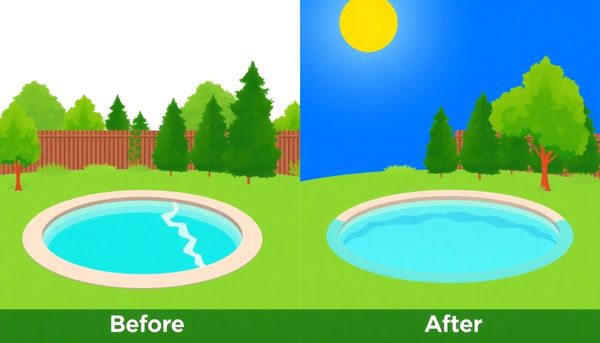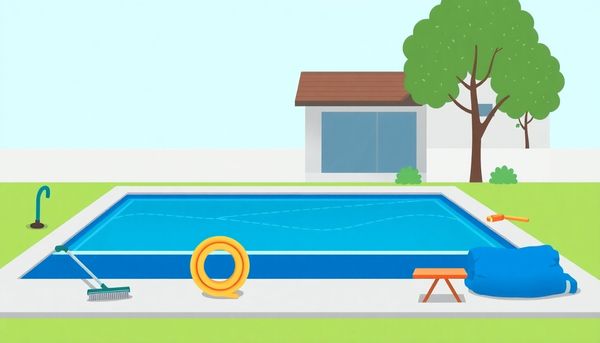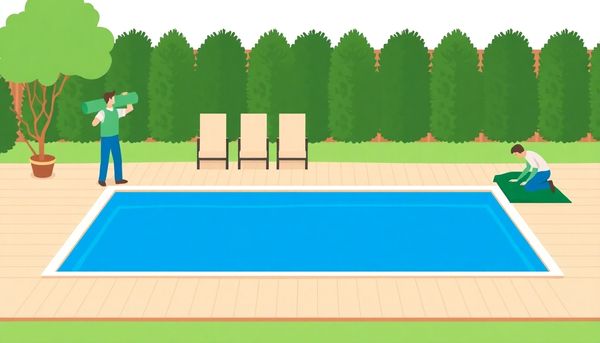Essential Guide to Replacing Your Inground Pool Liner
June 12th, 2024
June 12th, 2024
For many, an inground pool is the centerpiece of summer fun, a shimmering oasis that transforms a backyard into a personal retreat. But over time, the vital component that keeps the water contained and the experience enjoyable—the pool liner—can begin to show its age. Understanding when and how to replace this essential barrier can save both headaches and money in the long run.
Years ago, when my own pool liner started to fade and crack, I found myself facing a decision I hadn’t anticipated. The once vibrant blue had dulled significantly, and small leaks were becoming frequent visitors. Through that journey, I learned that liners typically last around 10 to 15 years, although this can vary based on the weather conditions and maintenance routines.
One morning, I noticed a particularly persistent leak near a seam, a telltale sign of an impending replacement. It wasn't just about aesthetics anymore; it was about functionality and safety. A damaged liner can cause more than just water loss; it can lead to structural problems if left unattended.
Replacing a pool liner might seem daunting, but equipped with the right knowledge and timing, it can be a straightforward process. By recognizing the signs of wear—fading color, cracks, and stubborn leaks—you’ll be better prepared to keep your pool in top shape, ensuring countless seasons of enjoyment under the sun.

In the midst of all the balance chemicals and maintenance routines, pool liners often become the unsung heroes of our backyard retreats. Yet, their silent endurance can only last so long before small signs of wear begin to emerge. To catch these signals before a minor inconvenience turns into a major headache, it's crucial to keep an eye on common indicators of liner damage.
A subtle dip in your pool's water level might seem innocuous at first. However, if you're noticing a drop that's more than an inch each week, it could be the liner's way of waving a red flag. Leaks can start small, often escaping notice until they begin to affect not just the water level, but also the pool structure and surrounding areas. It's worth performing a dye test around suspected areas to confirm a leak.
Also, keep an ear out. The sound of water trickling when the pool is silent can be a dead giveaway. In addition, visual inspections can reveal early signs of trouble. Look for areas where the liner appears faded, brittle, or has blisters. These can lead to tears, especially when paired with the constant expansion and contraction caused by changing temperatures.
Even the most innocent-looking scratch or tear from a pet's claws or debris could spell trouble in the long run. Addressing these issues promptly with a patch kit might buy some time, but recognize when the liner's whispers turn into a cry for replacement. Catch these cues early, and you can smooth the path to a fresh, durable liner that keeps your pool ready for endless summer fun.
Sunshine may be delightful, but its UV rays have other plans for your pool liner. Over time, exposure to these rays can lead to fading and, more critically, weaken the liner, making it brittle and susceptible to tearing. It's like leaving out a favorite book too long in the sun—eventually, the cover fades and pages become fragile. So, how do you extend the life of your pool liner under the relentless sun?
Start by investing in a quality pool cover. Not only does it shield your liner from UV damage, but it also keeps debris out, reducing the frequency of cleaning—an added bonus! Another savvy move is using pool chemicals wisely. While chlorine is essential for keeping water clean, an overdose can accelerate liner degradation. Regularly test water levels to ensure the balance is just right, avoiding unnecessary wear.
Consider also the use of UV protectant sprays specifically designed for vinyl. These can provide an additional layer of defense against the sun's rays. It's a bit like applying sunscreen to your pool, ensuring it stays in top shape season after season. Plus, if your budget allows, installing a partial or full pool shade can be a stylish and practical way to protect both swimmers and the liner from excessive sun exposure.
By taking these preventive measures, you'll not only preserve the vibrancy of your pool liner but also enhance its longevity, saving you from premature replacements and maintaining your pool’s aesthetic appeal.
Pool liners, sturdy as they are, often face the brunt of chemical exposure. While maintaining pristine water is crucial, the methods used can inadvertently damage the liner. Over time, excessive chemical use, especially high chlorine levels, can be just as detrimental to your vinyl as they are functional for the cleanliness of your pool. Chlorine, an essential element in keeping pool water sanitized, can, in surplus, begin to degrade the liner. This degradation isn't immediate but occurs gradually, often going unnoticed until it manifests as brittleness or tiny fissures.
Think back to a time when you laundered a favorite shirt only to find it threadbare after too much bleach. The same principle applies to your pool liner. It’s a delicate balance; too little chemical and you risk bacterial growth, too much and your liner pays the price. Therefore, testing and balancing the water chemistry should be a regular part of your routine. Invest in a high-quality testing kit and monitor pH levels, alkalinity, and calcium hardness vigilantly.
Moreover, it’s worth considering alternatives or complements to chlorine, such as saltwater systems or UV sanitation. These systems can be gentler on the liner while still maintaining water quality. By addressing chemical exposure proactively, you not only extend the life of your liner but also ensure that your pool remains a safe and enjoyable place to swim.
While pool liners silently bear the brunt of your pool’s existence, certain physical hazards can hasten their demise, leaving you with little choice but to replace them sooner than expected. A wise pool owner knows how to shield their liner from these potential threats.
Consider this: a neighbor's rogue lawnmower unleashes debris like an impromptu hailstorm. That stray rock might land with enough force to pierce your precious liner. Employing a simple fence or barrier around your pool can intercept such aerial assaults, protecting the integrity of your liner.
Weather, too, is a relentless adversary. I remember one summer storm when heavy branches battered down into my own backyard oasis, transforming it into a chaotic mess of leaves and broken limbs. By trimming trees regularly and securing loose items in anticipation of severe weather, you can prevent similar mishaps.
And let's not overlook our furry companions who revel in aquatic fun. Their enthusiasm can turn costly if you’re not careful. Trimmed nails and supervised dips ensure that your dog remains a friend to your pool, not a foe to its vinyl lining.
By taking these preventative measures, you increase the lifespan of your liner, ensuring that your pool remains a haven of relaxation rather than a site of unexpected repairs. Keep these hazards in check, and you’ll enjoy more splash-filled summers with less worry.

Neglecting a pool liner is easy when you're focused on maintaining water chemistry or ensuring every pump and filter runs without a hitch. Yet, this unsung hero holds the entire aquatic experience together, keeping all that water securely in place. Safeguarding your liner not only extends its lifespan but also saves you from the hassle and expense of premature replacement.
Start by controlling sunlight exposure. The sun’s UV rays, while great for a tan, wreak havoc on pool liners. A solar cover can mitigate this damage, reducing bleaching and brittleness. It's a simple investment that shields your liner from the relentless sun, ensuring it remains vibrant and flexible for years.
Chlorine, the defender against bacteria, can become an enemy if overused. Keep its levels balanced to prevent the gradual erosion of your liner. Regularly test your water and adjust chemicals accordingly to strike a perfect balance.
Physical damage is another culprit. Keep an eye out for errant sharp objects that might sneak into your pool, whether from a lawnmower mishap or a gusty storm. A pool cover when the pool's not in use can protect against unexpected debris.
And don’t overlook your pets. Dogs love a cool dip, but their nails can accidentally tear the liner. Consider a designated swim area or ensure their nails are well-trimmed before they dive in.
By taking these preventative measures, you’ll not only protect your liner but also preserve the beauty and functionality of your pool, keeping it swim-ready for many seasons to come.
A new pool liner can feel like a fresh start for your backyard oasis, but the sun's relentless ultraviolet (UV) rays can be a sneaky foe, slowly undermining its longevity. It’s easy to overlook how sunlight impacts the materials of your pool, especially since a sunny day often invites us for a swim. However, UV rays don’t just tan skin; they also bleach and weaken vinyl liners, particularly around the waterline where exposure is most intense.
Years ago, I learned this lesson the hard way. After noticing the top edge of my pool liner looking a bit washed out, I realized it had become brittle from the sun's constant glare. Investing in a good-quality pool cover can significantly reduce such damage. Not only does it shield the liner when the pool isn't in use, but it also preserves the water’s chemical balance, sparing you the extra chlorine that can further degrade the liner.
Additionally, consider planting shade-giving trees or installing a canopy. While these might cast shadows over your pool, they provide natural protection against UV damage without obstructing your swim sessions. Remember, a liner might appear sturdy, but proactive care against sun exposure can extend its life and keep your pool sanctuary looking vibrant for longer. With these little adjustments, you can enjoy your summer swims without worrying about hidden harm beneath the water's surface.
Balancing the chlorine levels in your pool is like walking a tightrope. Too little, and you risk murky waters; too much, and the very foundation of your pool—the liner—takes the hit. Over-chlorination might not seem like a big deal at first, but over time, it can cause the liner to deteriorate prematurely, leading to costly replacements sooner than you'd like.
For instance, remember that neighbor who thought adding extra chlorine would save time? They ended up replacing their liner within a few years. While chlorine is a powerful ally in keeping your pool pristine, moderation is key. Check your pool's chlorine levels regularly using a reliable test kit. Aim for levels between 1.0 and 3.0 parts per million (ppm) for optimal results. It's a small step that can add years to your liner's life.
Additionally, consider other methods to maintain your pool's cleanliness that won't punish the liner. Saltwater systems, for instance, provide a gentler alternative with consistent sanitization. Or, try using a pool cover when the pool is not in use. This will protect the water from debris and limit chlorine loss due to sunlight exposure. By giving your liner the attention it deserves, you ensure that it continues to do its job without going on strike.
Scratches on your pool liner from pets often start with playful afternoons in the sun. Our furry friends love to jump in and out of the water, oblivious to the delicate vinyl beneath their paws. One summer, my golden retriever, Max, decided to take a flying leap into the pool every chance he got. His enthusiasm was infectious, but his nails left a trail of tiny scratches across the liner.
To prevent such damage, keeping your pet's nails trimmed is the first step. It’s not just about aesthetics; shorter nails are less likely to pierce the liner. Consider investing in a pet ramp or pool stairs to give your four-legged buddy a safer entry and exit route. This simple addition can significantly reduce the risk of them clawing their way out on the pool wall.
Another tip is to designate a specific area for your pet to splash around. By directing their energy to a particular section, you manage their interactions with the pool more effectively. Ensuring this area is free from sharp toys or objects also helps.
Remember, keeping an eye on your pool liner when pets are around can save you the hassle and expense of premature replacement. With a bit of foresight and care, you can strike a balance between a fun swimming experience for your pets and a long-lasting pool liner.

Replacing your inground pool liner is not just about aesthetics; it's a critical maintenance step to ensure the longevity of your pool. Selecting high-quality replacement materials is crucial, and it all starts with understanding the components that make up a top-notch liner. One summer, a friend of mine replaced their liner with a low-cost alternative, thinking it would save them money. Within a year, they were dealing with fading and small punctures, leading to more frequent repairs than anticipated. This story underscores the importance of investing in quality.
First, consider the material. Virgin vinyl is often the go-to choice. Unlike recycled vinyl, virgin vinyl is composed of pure material, which means it lacks impurities that can weaken the liner over time. It’s more resilient to the harsh effects of UV rays and temperature fluctuations. The thickness of the liner, measured in mil, also plays a role. While thicker liners, like those around 30 mil, provide more durability, balance this with the flexibility needs of your pool. Sometimes, a 20 mil liner made of virgin vinyl may outperform a thicker, less pure one.
Finally, don't overlook the warranty details. A comprehensive warranty can serve as a safety net, protecting your investment against defects or premature wear. By prioritizing these factors, you ensure not only the beauty but also the structural integrity of your pool for years to come.
When the time comes to replace your inground pool liner, selecting the right vinyl option is crucial for ensuring a long-lasting solution to your pool's needs. The choice of vinyl directly influences the durability and longevity of your liner, and it's more than just picking a pretty pattern. Let’s break down what to consider for a smart selection.
Start by looking at the vinyl's composition. Virgin vinyl, which contains no recycled materials, is often the superior choice. Its uniformity allows it to withstand temperature fluctuations and UV exposure more effectively, minimizing the risk of weak spots. Unlike composite vinyl, which might degrade more quickly, virgin vinyl offers resilience that can see your liner through many seasons of sun and swim.
Next, pay attention to the thickness of the vinyl. Measured in mils, thicker liners generally offer enhanced resistance to punctures and tears but may not always be necessary if you’re investing in high-quality virgin vinyl. For context, a 20-mil liner is akin to two sheets of paper, whereas a 35-mil liner approaches the thickness of a credit card. While a thicker liner can offer peace of mind, it's important to weigh this against cost and the specific conditions of your pool environment.
Lastly, don’t overlook the warranty details. A robust warranty could save you substantial repair costs down the line. Check what’s covered and how long the protection lasts because warranties can vary widely in terms of coverage and duration. Making an informed choice in these areas will ensure your pool is ready for many more years of enjoyment.
Sunshine may be the lifeblood of summer, filling our days with warmth and brightness, but it’s also silently plotting against your pool liner. Ultraviolet (UV) rays don’t just bleach vibrant colors into faded memories; over time, they compromise the integrity of the liner itself. When the vinyl’s surface, especially the area exposed above the waterline, becomes brittle, it’s a sign that those sun-soaked days have taken a toll. This deterioration can lead to cracks and leaks, demanding not just a patch-up job but a full liner replacement.
But it's not just the sun that's working against you. Chemicals, particularly chlorine, are the unsung heroes in the battle for clean water. Yet, they can become silent enemies if overused. Imagine the slow, almost imperceptible erosion happening beneath your feet. Just like excessive bleach can ruin a good shirt, too much chlorine can steadily eat away at the vinyl, creating weak spots that are a precursor to bigger problems.
You might think back to a time when you tossed an errant pool toy or noticed your dog’s enthusiastic splash sessions. All these contribute to incremental wear. Monitoring the sun and chemical exposure offers an early warning system. Paying attention to these factors can postpone the inevitable liner replacement, saving you both time and money down the line. Keep your pool a haven by balancing these impacts before they escalate, and your liner will thank you by working tirelessly beneath the surface.
When the time comes to replace your inground pool liner, the first hurdle is ensuring those measurements are spot on. Trust me, this isn't just a task; it's an art that demands precision. Getting it right means avoiding the costly mistake of a liner that doesn’t fit, leaving you with a chaotic, waterlogged backyard.
Start by gathering the right tools: a tape measure, a telescopic pole, and, perhaps, a pair of extra hands. Diving into the details, remember that even simple shapes like rectangles require double-checking at two points to confirm consistency. For curves and unique shapes, like ovals or custom designs, the complexity increases. Each pool has its quirks, and a miss here or there can lead to frustrating misfits.
Consider professional help if your pool's shape resembles anything more exotic than a rectangle. It’s an investment in peace of mind and ensures your new liner will hug your pool's contours perfectly. Whether you decide to tackle the task or call in an expert, the key takeaway is double, even triple-checking every measurement.
Remember, the precision at this stage sets the foundation for a stress-free liner installation. While it might seem intense, this attention to detail transforms the daunting into doable, ensuring your pool is ready to provide endless summer enjoyment.

Accurate measurement is the cornerstone of a successful pool liner replacement. Think of it as the blueprint that guides the entire operation. Just like a tailor needs precise measurements for a perfect suit, an improper fit in your pool liner can lead to leaks, wrinkles, and wasted resources. If you've ever tackled a DIY project that required exact dimensions, you know the frustration of mismatched parts.
Start by gathering your tools: a long measuring tape, a chalk line, and possibly a friend or two to assist. For rectangular pools, measure the length and width at multiple points and ensure consistency across your findings. Oval pools demand attention to both end-to-end and width measurements, while round pools will have you double-checking diameter across various axes. It's critical to measure from inside the pool walls; the liner should snugly cover these areas without climbing onto the deck.
One might consider enlisting a professional for uniquely shaped pools. A miscalculated slope or uneven wall could throw off your entire effort, similar to when your recipe calls for baking soda and you mistakenly grab baking powder—close, but not quite right. Some companies offer templates or apps to streamline the process, but nothing beats the confidence provided by an experienced pro.
Ultimately, precise measurements ensure your new liner fits like a glove, sparing you the headache of adjustments and ensuring your pool is ready for many more seasons of enjoyment.
When considering the lifespan of your inground pool liner, it's crucial to identify potential sources of damage early on. Like that time when my neighbor’s dog decided the pool was his personal playground, and his sharp claws left a few noticeable marks—not exactly what you want on your weekend maintenance list. Pets can be unwitting culprits, especially if they enjoy a spontaneous dip.
Another unexpected hazard comes from the skies. Bad weather can be relentless, with branches or debris making their way into your pool during a storm. Each gust of wind can act as a delivery service for potential damage, scuffing or tearing the liner as it lands. It pays to survey your surroundings and trim back any overhanging trees that might be a threat.
Chemical imbalance in the pool is another silent offender. While we all want that crystal-clear water, overdoing it with chemicals like chlorine can lead to the liner becoming brittle over time. It's much like overbleaching your favorite shirt—it might look clean, but it won't last long.
Finally, consider the sun's relentless rays. Those UV beams can do more than just give you a tan; they can fade and weaken the portion of your liner that peeks above the water. Using a pool cover during peak sun hours can extend your liner's life significantly. By keeping an eye on these damage sources, you'll be better equipped to maintain your pool liner and preserve your pool’s longevity.
Choosing the right materials for your inground pool liner is not just about aesthetics—it's a decision that impacts the longevity and performance of your pool. When I first decided to replace my own pool liner, I quickly learned how crucial it is to invest in quality materials. The thickness, type, and origin of the vinyl can make a world of difference.
A key term to understand is "virgin vinyl." Unlike recycled or composite vinyl, virgin vinyl is made without any recycled materials, ensuring a consistent and durable product. This type of vinyl resists fading and brittleness better than others, which can be particularly important if your pool is exposed to lots of sunlight. I once opted for a liner that wasn't virgin vinyl, and within two years, it started showing signs of wear and tear.
Thickness also plays a significant role in durability. Pool liners usually range from 20 to 35 mils in thickness. While thicker liners often provide more durability, they can also be more challenging to handle during installation. I found a 28/20 mil liner, with the thicker vinyl used for the walls, to be a perfect balance. It was sturdy enough to withstand regular use and environmental stresses, yet flexible enough for a relatively easy installation process.
Finally, always scrutinize the warranty before making a purchase. The fine print can vary greatly, so it's essential to understand what is covered. A longer warranty might seem appealing, but ensure it covers significant issues rather than a laundry list of minor ones. Investing in a high-quality liner now can save you from headaches and extra costs down the road.
Ensuring your pool's liner fits like a glove begins with meticulous measurements. It's the step that can make or break your entire liner replacement project. My friend once attempted to measure her uniquely shaped pool without professional help—only to find her new liner didn’t quite align, resulting in another costly order. Avoid her fate by taking time to gather precise dimensions.
First, gather your tools: a tape measure, a telescoping pole, chalk, and possibly a friend to help with those pesky angles. For rectangular pools, measure not just one side, but two to confirm uniformity. This double-checking reduces the margin of error significantly. Ensure your tape is pulled taut and that you’re measuring inside the pool walls, not above the coping.
Oval and round pools require a slightly different approach. Here, measuring the longest and shortest diameters will reveal any discrepancies in shape. If you stumble upon unusual corners or slopes, don’t hesitate to consult a professional; they can save you from costly mistakes.
Record depth measurements too. Use a pole to gauge from the shallow to the deep end, marking significant changes with chalk. This helps you ensure that the liner will snugly fit the pool's unique contours.
After all, a well-measured pool is one step closer to a perfectly fitted liner, leading to years of carefree swimming enjoyment.

Swapping out an inground pool liner might seem like a straightforward DIY project, but there's more to it than meets the eye. While many are tempted to tackle the task themselves, enlisting professional help can save time, stress, and potential mishaps. Think about it: precise measurements and proper installation techniques aren't just nice-to-haves—they're essentials. An incorrectly fitted liner can lead to costly water loss and damage to the pool's structure.
Beyond the basics of ensuring the liner fits snugly, professionals bring an expertise that accounts for factors you might overlook. They are trained to manage the challenges of liner installation, such as uneven pool floors or complicated pool shapes. Their experience helps avoid rookie mistakes, like improper vacuuming out of air pockets or incorrect liner alignment, which can result in wrinkles and leaks.
Reflect on the level of comfort you feel with the tools of the trade. A seasoned installer comes equipped with the right gadgets and knows exactly how to use them for a flawless finish. Plus, hiring a professional often comes with warranties on their work, offering an added layer of security and peace of mind.
Choosing professional installation might feel like a splurge, but it ensures your pool is ready for countless summers of enjoyment. Consider this investment as a safeguard for your leisure and relaxation, not just a task ticked off the list. In the end, the value lies in knowing the job is done right the first time.
Accurate measurements are the keystone to a successful pool liner replacement. Consider the intricate art of tailoring; a suit can only fit perfectly if every measurement is precise, and the same applies to your pool liner. If you've ever tried hemming pants only to find them still brushing the ground, you'll understand why precision is non-negotiable.
The complexity of pool shapes can easily trip up even the most meticulous DIY enthusiast. While a rectangular pool might present a straightforward task, freeform or kidney-shaped pools can feel like deciphering a treasure map. Each curve and corner demands attention to detail, lest you order a liner that simply won't fit. It's not just about the length and width; depth plays a crucial role too, and overlooking even an inch can lead to an ill-fitting liner.
Don't be afraid to enlist a professional for this task. Their expertise can save you from costly mistakes. If you're set on doing it yourself, ensure your tools are up to the mark – a flexible tape measure, a partner to hold the other end, and perhaps a waterproof notepad for jotting down numbers as you go. Remember, this is one puzzle where all pieces must interlace perfectly. A bit of extra effort in this phase will ensure a snug fit, leaving you to enjoy your pool without a hitch.
Avoiding mishaps during pool liner installation is crucial, not just for the integrity of your liner, but for the longevity of your pool as a whole. Starting a project without understanding the potential pitfalls can lead to costly errors. Take, for instance, the time I decided to replace my own pool liner. I thought I had everything under control, but overlooked the proper alignment of the liner bead with the track. The result? A frustrating redo that cost both time and patience.
First and foremost, ensure you prep the pool surface meticulously. Any sharp objects or debris should be removed to prevent punctures. This step is often underestimated, yet it’s essential for maintaining your liner's durability. I remember neglecting this detail, and ended up with a small tear from a hidden pebble.
Next, be cautious with measurements. Double-checking dimensions can save you from the heartache of a poorly fitting liner. Templates or measuring apps can be immensely helpful, especially with non-rectangular pools. If possible, consult a professional for these measurements to avert any miscalculations.
Furthermore, manage temperature conditions during installation. Vinyl liners are more pliable in warmer temperatures, making a snug fit easier to achieve. A cold, brittle liner can lead to tension issues and improper fitting.
Finally, always seek advice if unsure. Whether consulting an expert or using instructional resources, gaining clarity can prevent a host of issues. With the right preparation and attention to detail, your liner installation can be as smooth as a calm day by the pool.

This article provided insights into maintaining your pool. Start your pool care journey today!
Want to become a pool maintenance expert? Our free Pool School course covers everything you need to know about pool care. From basic maintenance to advanced troubleshooting, you'll learn how to:
Join over 10,000 pool owners who have already transformed their pool care routine. Get started with our free Pool School course today!